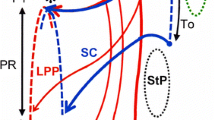Abstract
The aim of this study was to clarify the topography of the longitudinal pharyngeal muscles and to relate the findings to pharyngeal muscular function. Forty-four specimens (22 right and 22 left sides) from embalmed Korean adult cadavers (13 males, 9 females; age range, 46–89 years; mean age, 69.2 years) were used in this study. The palatopharyngeus muscle originated from the palatine aponeurosis and the median part of the soft palate on oral aspect; it ran downward and lateralward, respectively. The palatopharyngeus muscle, which held the levator veli palatini, was divided into two bundles, medial and lateral, according to the positional relationship with the levator veli palatini. The lateral bundle of the palatopharyngeus muscle was divided into two parts: longitudinal and transverse. The pharyngeal longitudinal muscles were classified into the following four types (I–IV) depending on the area of insertion: they were inserted into the palatine tonsil, epiglottis, arytenoid cartilage, piriform recess, thyroid cartilage, and pharyngeal wall. The transverse part of the palatopharyngeus muscle plays a role as a sphincter. Palatopharyngeus and levator veli palatini muscles help each other to function effectively in the soft palate. The present findings suggest that the pharyngeal muscles are involved not only in swallowing but also in respiration and phonation via their attachment to the laryngeal cartilage.










Similar content being viewed by others
References
Borley NR, Standring S, Gray H. Gray’s anatomy : the anatomical basis of clinical practice. Edinburgh: Churchill Livingstone; 2008.
Sumida K, Yamashita K, Kitamura S. Gross anatomical study of the human palatopharyngeus muscle throughout its entire course from origin to insertion. Clin Anat. 2012;25:314–23. doi:10.1002/ca.21233.
Meng H, Murakami G, Suzuki D, Miyamoto S. Anatomical variations in stylopharyngeus muscle insertions suggest interindividual and left/right differences in pharyngeal clearance function of elderly patients: a cadaveric study. Dysphagia. 2008;23:251–7. doi:10.1007/s00455-007-9131-2.
Okuda S, Abe S, Kim HJ, Agematsu H, Mitarashi S, Tamatsu Y, et al. Morphologic characteristics of palatopharyngeal muscle. Dysphagia. 2008;23:258–66. doi:10.1007/s00455-007-9133-0.
Kahrilas PJ. Pharyngeal structure and function. Dysphagia. 1993;8:303–7.
Tsumori N, Abe S, Agematsu H, Hashimoto M, Ide Y. Morphologic characteristics of the superior pharyngeal constrictor muscle in relation to the function during swallowing. Dysphagia. 2007;22:122–9. doi:10.1007/s00455-006-9063-2.
Vandaele DJ, Perlman AL, Cassell MD. Intrinsic fibre architecture and attachments of the human epiglottis and their contributions to the mechanism of deglutition. J Anat. 1995;186(Pt 1):1–15.
Ekberg O, Sigurjonsson SV. Movement of the epiglottis during deglutition. A cineradiographic study. Gastrointest Radiol. 1982;7:101–7.
Reidenbach MM. Aryepiglottic fold: normal topography and clinical implications. Clin Anat. 1998;11:223–35. doi:10.1002/(SICI)1098-2353(1998)11:4<223::AID-CA1>3.0.CO;2-S.
Negus V. The comparative anatomy and physiology of the larnyx. New York: Hafner; 1949.
Moore KL, Dalley AF. Clinically oriented anatomy. Philadelphia: Wolters Kluwer; 2010.
Tank PW, Gest TR, Burkel WE, Wilkins LW. Lippincott Williams & Wilkins atlas of anatomy. Philadelphia: Wolters Kluwer Health/Lippincott Williams & Wilkins; 2009.
Schünke M, Schilte E, Schumacher U. Thieme atlas of anatomy. Stuttgart: Thieme; 2006.
Hwang K, Kim DJ, Hwang SH. Microscopic relation of palatopharyngeus with levator veli palatini and superior constrictor. J Craniofac Surg. 2009;20:1591–3.
Conflict of interest
We did not receive any equipment, materials and medications for this study.
Author information
Authors and Affiliations
Corresponding author
Rights and permissions
About this article
Cite this article
Choi, DY., Bae, JH., Youn, KH. et al. Anatomical Considerations of the Longitudinal Pharyngeal Muscles in Relation to their Function on the Internal Surface of Pharynx. Dysphagia 29, 722–730 (2014). https://doi.org/10.1007/s00455-014-9568-z
Received:
Accepted:
Published:
Issue Date:
DOI: https://doi.org/10.1007/s00455-014-9568-z




